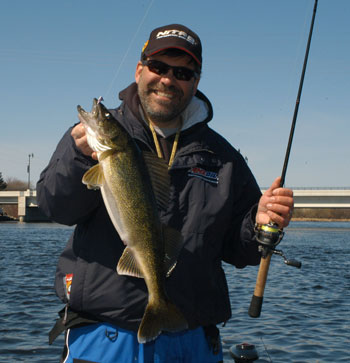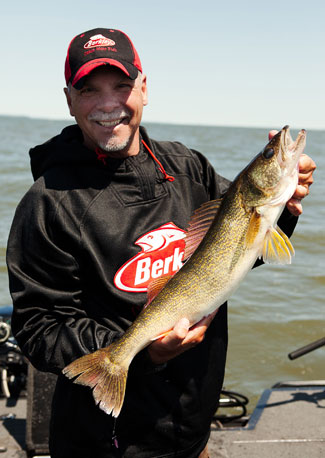Over the years we have penned many articles covering all the various aspects and patterns for fall walleye fishing. Looking over all that material we’ve determined that no matter where you fish for walleyes, there is at least one of five primary patterns that would most likely work for you to put some fish in the boat. We’re not putting these in any particular order of effectiveness or importance because the best tactic for you will depend on the water and conditions you are fishing. The important thing is that you learn each pattern so that when the right scenario presents itself, you will be ready for some great fall walleye fishing.
Gary Parsons and Keith Kavajecz
Over the years we have penned many articles covering all the various aspects and patterns for fall walleye fishing. Looking over all that material we’ve determined that no matter where you fish for walleyes, there is at least one of five primary patterns that would most likely work for you to put some fish in the boat. We’re not putting these in any particular order of effectiveness or importance because the best tactic for you will depend on the water and conditions you are fishing. The important thing is that you learn each pattern so that when the right scenario presents itself, you will be ready for some great fall walleye fishing.
 Jigging Rivers:
Jigging Rivers:
While there are exceptions, typically rivers will be at their lowest levels as autumn begins. The fish are moving to where they will spend the winter. You need to intercept them in those spots where their migration route offers good feeding opportunities. Key in on the channel edges; places where the channel changes. These are the spots that walleyes will use as “rest stops” and feeding stations. Incoming creeks will form a delta or a hump where it contacts the main channel. Wing dams are always going to attract fish and outside bends in the channel create wash-outs and eddies are good areas to hold walleyes. These are all prime spots for Vertical Jigging.
Normally you’re dealing with fairly light current and moderate depths so keep your jig selection in the 1/8 to 3/8 ounce range. Jigging action can be a bit more aggressive than you used in the spring, but it often makes a big difference in the number of bites you’ll get if you get in the habit of leaving your jig rest on the bottom a little longer than you normally do. Opting for a semi-stand-up style jig, like the Bass Pro Shops XPS Walleye Angler Jig, will position the bait angling slightly off bottom, making it an easy target to get slurped up. Bulking up your jig offering, either by using larger-than-average sized minnows (four to five inchers are good), or by adding a plastic body such as a four inch Berkley GULP! Minnow or a four inch Berkley PowerBait Ripple Shad will add the size and attraction to get these fall walleyes’ attention.
Trolling Cranks at Night on the Great Lakes:
Finding walleyes on the Great Lakes in the fall is a matter of knowing migration patterns too. On Lake Erie for example, walleyes move from the eastern and central basins toward the western waters. Open water trolling tactics are still effective this time of year, but you’ll do better to concentrate your efforts more “in-shore”, than out over the main basin. Look for the majority of fish to relate closer to breaks, where the basin transitions to shallower water. The same principal holds true on most of the Great Lakes waters from Chequamegon Bay on Lake Superior to the Bay of Quinte on Lake Ontario. Walleyes will move from the main lake toward the bays and shoreline breaks where they’ll spawn come spring.
This is the time of year on many of these waters that night fishing is at its peak. Large, shallow running crankbaits trolled over large flats or just off large reef structures can be very productive. Of course night fishing offers a whole new set of challenges. You’ll still want to utilize such trolling accessories as in-line boards to spread your lures out and cover water. But at night, reading those boards can be tough. Off Shore Tackle offers the OR-32 (red light) and OR-33 (green light) Night Lights for use on the popular OR-12 or OR-31 Side Planer boards. These are basically “lighted flags” designed to replace the standard flag on the Off Shore boards in night fishing situations. The lights are visible for 360 degrees, allowing not only you to see them, but also other boaters in the area.
Contour Trolling with Lead Core:
If your home water is, or resembles, one of the western reservoirs, your approach to catching walleyes will need to be a bit more aggressive. These are expansive lakes, with tons of structure and water to cover in order to locate walleyes staging up for the cold water season.
The key is to fish sharp breaking structure. In the fall the walleyes on these waters like to relate to steep breaks, whether that be off the edge of large main-lake flats or large main-lake points. Contour trolling crankbaits with lead core line is a tactic that excels under these conditions. The lead core allows you to fish a variety of depths along the break by varying your trolling speed. Slow down, and the lead core sinks, speed up and the lead core raises the bait. Lead core tolling seems to work best with smaller, shallow running crankbaits like the Berkley Flicker Shads in the 4 cm or 5 cm sizes.
 Slow Death Rigging:
Slow Death Rigging:
As the waters cool in natural lakes and small reservoirs, walleyes will begin to congregate in defined areas, often along deep weed edges or on main-lake reef structures. One presentation we’ve found that seems to work every bit as well in fall as it does in summer is “Slow Death” rigging. If you aren’t familiar with it, it’s a modification of the bottom bouncer live bait rig that when rigged correctly, presents a piece of nightcrawler in a “death roll’ spinning motion that triggers walleyes like nothing else. The secret to Slow Death is in the hook. We used to bend an Aberdeen hook to get the right spin on the bait. Mustad has now introduced a hook designed specifically for this tactic, appropriately enough called The Slow Death Hook (model 33862) that has the perfect bend to give the action needed to make this presentation work.
Rigging Big Minnows/Chubs:
Big reservoirs and large natural lakes can sometimes produce big walleyes. From their summer hang-outs on flats and feeding shelves, these walleyes like to move to such locales as main-lake points and shorelines that feature sharp breaks and access to deep water. These types of structures harbor the most baitfish this time of year, and walleyes will always be where their food source is. The fish will be loosely concentrated in spots, which makes hunting them down with your electronics efficient. Cruise likely structure searching out signs of life such as clouds of bait, and those tell-tale “arcs” indicating larger predators. Once a school is located, a slow and deliberate presentation will get the most bites. It’s tough to beat a big minnow put right in the fish’s face in fall. Creek Chubs are a favorite bait preference, but Red Tails, Dace and Suckers will work too. Keep the bait selection on the large side … if a six to seven inch minnow looks too big, then it’s probably just right. Remember, fall on many of these waters is trophy time, and a big minnow offers a walleye the most meal for the least amount of effort.
Using bait that big means you’ll need to choose a hook with enough “gap” to get the job done too. A Mustad Double Wide Fine Wire Bait Hook (model 10548R) in size 1 or 1/0 (to match the size of the bait being used) is a great choice. This hook features Mustad’s Ultra Point technology and it’s a super fine-wire hook giving it superior penetration. This is one of the best presentations we know of for targeting really big fish in the fall.
Summary:
The fall of the year can be a trying time for anyone that loves the outdoors. There are so many things that peak this time of the season … there’s the kid’s school activities, hunting is in full swing, you want to follow your favorite football team and fishing is at a peak for many species. It’s no wonder many of us border on panic and exhaustion trying to fit it all in these few short weeks. But if you’re a hard-core walleye angler, this is the time to be on the water, and chances are one of these top fall patterns will be just the ticket to help you get your Next Bite.










